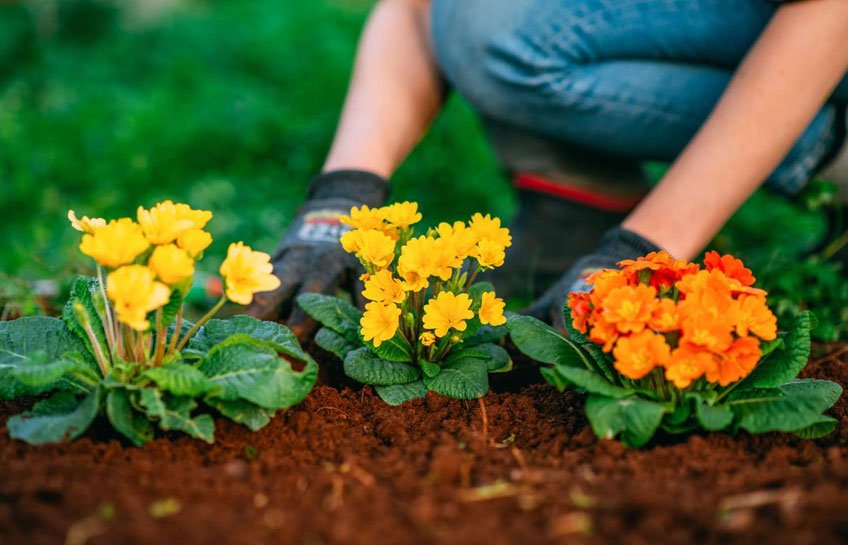Welcome to the wonderful world of flower gardening! Adding vibrant blooms to your outdoor space is deeply satisfying and rewarding. Beyond the beauty, flower gardens also attract pollinators, reduce stress, and provide cut flowers for seasonal decorating.
This article will guide you through the entire process as a beginner, from planning your garden to caring for it long-term. Follow these tips and you’ll be on your way to a thriving flower patch!
Understanding the Basics of Flower Gardening
Before digging in, it’s important to understand some flower gardening basics regarding sun, soil, and water. This will determine what flowers thrive and inform how you prepare the space.
Sun Exposure
Most flowers require at least 6 hours of direct sun exposure daily. Evaluate your yard to identify the sunniest spots. Also note how the sunlight shifts with the seasons.
If space is limited, consider a sunny corner along the house or creating an elevated garden in full sun. Shade-loving flowers like impatiens and begonias are exceptions for areas with less light.
Soil Quality
Flowers need nutrient-rich, well-drained soil to fuel their growth and bloom cycles. Test your yard’s soil first to determine if amendments could help. Key indicators are:
- Soil texture – Sandy soils drain quickly while clay soils get waterlogged
- pH levels – Most flowers thrive in slightly acidic soil with a pH of 6.0-6.7
- Nutrient levels of nitrogen, phosphorus and potassium (NPK)
Based on the test results, you can add organic material like compost or use lime to balance the pH before planting.
Water Needs
Adequate, consistent water keeps flowers looking vibrant. Most require about 1-2 inches of water per week from rain or irrigation. Install a drip irrigation system or use a watering can to prevent fungal diseases.
During hot and dry periods, check soil moisture about 2 inches down. Water thoroughly when the top few inches become dry but before plants start to wilt.
Choosing the Right Flowers for Your Garden
With proper growing conditions in place, it’s time to choose flowers! First, decide if you want to plant annuals (one season) or perennials (return each year) since their care and costs differ significantly.
You’ll also need to match flowers to your yard’s unique sunlight, soil and climate. Use this comparison table to help select the best varieties to start:
Annuals
Annual flowers have a one-year life cycle. They provide months of vibrant color so are perfect for flower beds and containers. Choose annuals based on your region and preferred bloom season:
- Spring & Summer Annuals – Marigolds, zinnias, pansies
- Cool Weather Annuals – Snaps, poppies, primrose
- Fall Annuals – Asters, mums
Sow annuals from seed or buy starter plants after the last spring frost. Place them in prepared garden beds or containers with rich potting mix, spacing according to plant tag instructions.
Perennials
Perennial flowers return year after year, steadily expanding in size and offering reliable color once established. Popular options include:
- Early Spring – Tulips, bleeding hearts, crocus
- Summer – Daylilies, coneflowers, garden phlox
- Fall – Sedum, asters, chrysanthemums
Since they persist for years, site perennial flower beds thoughtfully and amend the soil with lots of compost before planting. Space plants according to their expected spread size to prevent overcrowding.
“The right tools can turn gardening from a chore into a joy.” – Monty Don, Gardener and TV Presenter
Essential Tools and Supplies for Flower Gardening
Starting any hobby calls for gathering the proper gear. For flower gardening, invest in these garden tools and supplies:
- Trowel – For digging holes to plant bulbs, seedlings or small plants
- Garden spade – Essential for edge, turning soil and dividing plants
- Rake – Prepare soil, remove debris and leaves, level spaces
- Gardening gloves – Protect hands from blisters, thorns and dirt
- Pruners and snips – Cut back dead foliage and harvest flowers
- Watering can – Gentle, direct watering of seedlings and potted plants
- Hose & attachments – Provides consistent irrigation for garden beds
- labels – Identify seedlings and track plants in beds
You’ll also need supplies to improve and maintain beds:
- Compost and fertilizer – Nutrients to enrich soil
- Mulch – Retains moisture and prevents weeds
- Pots and trays – To start seeds or nurture transplants
Gather these essentials before planting and your flower gardening is off to the right start. Most tools represent small investments that will serve you for many seasons.
Preparing Your Garden Bed
With the design complete and supplies on hand, it’s time to set up your flower bed for planting success. Follow these key steps:
1. Remove grass, plants and debris – Use a flat spade to edge and lift out sod in your planned bed space plus surrounding area. Pick up and dispose of rocks and existing plants you want to remove.
2. Till the soil – Break up and cultivate the first 8-12 inches of soil using a rototiller for large beds. Or dig vigorously by hand using your garden spade and fork.
3. Mix in compost – Work 2-3 inches of well-aged garden compost into the prepared bed space. Compost provides a slow-release nutrient boost to the soil.
4. Rake smooth & shape bed – Use a stiff garden rake to create a flat surface. Slope edges slightly higher than center to capture irrigation. Shape can be free-form or geometric.
5. Outline space – Use a hose or rope laid in your desired shape to visualize the planting area. Adjust outline if needed before adding soil amendments or plants.
6. Wait 2-3 weeks before planting – Irrigate newly prepared beds and let them rest. This allows organic matter you added to begin improving your native soil.
Preparing great soil is the secret to exceptional flowers. With rich, loose earth, your plants will thrive with less effort on your part.
Planting Your Flowers
The fun part has arrived! Follow this step-by-step flower garden planting guide once your bed is prepped and spring soil temperatures hold steady above 60°F (or as per plant tags):
1. Read plant tags – Brief yourselves on all planting specs like spacing, sunlight needs and bloom duration. Group plants with shared needs.
2. Set out plants – Place pots and packs where you anticipate planting before digging holes. Adjust layout until satisfied.
3. Dig proper-sized holes – Holes should be 2x wider than the root ball or pot width and 6 inches deep for most annuals and perennials.
4. Place & fill hole – Carefully remove from pots, loosen bound roots if growing in peat cups then place in hole. Position top of root ball level with the soil surface.
5. Backfill gently – Surround root balls with native soil, pressing firmly to make good contact. Water at soil level, not on leaves, to further settle.
6. Identify plants – Label each seedling with plastic markers noting the plant name and variety before forgetting!
7. Mulch beds – Spread 1-3 inches of shredded bark, compost or grass clippings around plants to limit weeds and retain moisture.
Follow proper planting techniques from the start and your flowers will have the roots, moisture and nutrients needed to begin blooming within a few months.
Watering and Fertilizing Your Flowers
Caring for flowers is rewarding when done consistently and correctly:
Water Needs
Most plants require one inch of water weekly from rain or irrigation. To gauge actual needs, dig down 2 inches and water at first signs of soil dryness. Early morning is ideal time to avoid foliar diseases. Thorough, deep irrigation also encourages deep roots.
Newly planted annuals and perennials require frequent, lighter watering initially. Then reduce frequency and soak deeper once established. Installing soaker hoses or drip irrigation ensures adequate moisture reaches bed plants’ roots without wasting water.
Fertilizer Feeding
While compost mixed into your beds provides basic nutrients, growing flowers still benefit from additional fertilizer during peak growing and bud development:
- Typical recommendation is 1/2 to 1 lb nitrogen per 1,000 square feet of planted garden space. This equals about 2 to 4 cups of all-purpose fertilizer spread atop the soil surrounding plants.
- Slow-release or organic formulas provide a steady nutrient supply so are safer for tender plants. Always follow label rates carefully.
- Feed annual beds monthly and apply new compost/fertilizer when replanting each year. Top dress perennials lightly in early spring and again after the main bloom period.
Proper water, nutrition and ample sunlight keep flowers looking lush, colorful and encourage prolific blooms to enjoy.
Ongoing Maintenance and Care
A flower garden requires regular care all season long:
Weeding Early & Often
Weed early and often by:
- Hand-pulling unwanted seedlings
- Hoeing to uproot emerging weeds
- Cutting off weeds at soil level before they go to seed
- Spreading 1-2 inches of organic mulch to block light and smother weeds
Staying on top of weeds reduces competition with flowers and limits seed formation. It also keeps beds looking neat and intentional.
Deadheading & Cutting Back Spent Blooms
“Deadheading” means removing faded blooms by pinching or snipping above a leaf node using hand pruners. This neatens plants, redirects energy to more flower production plus prevents unwanted self-seeding.
For tidy growth, cut back perennials by 1/3 their height after spring blooms fade. Fall-flowering plants should be deadheaded until hard frost for continual summer blooms.
Identifying & Managing Pests
Unfortunately insect pests and fungal diseases can attack lush blossoms. Learn to ID common culprits in your region, then employ natural defenses:
- Remove infested plants immediately to limit spreading
- Use row covers as physical barriers against insects
- Apply neem oil or insecticidal soap to control infestations
- Improve drainage and decrease watering to deter fungal disease
- Fertilize moderately since excessive nitrogen weakens plants
With attentive care and quick response to problems, your flower garden will keep its health, vigor and beauty all season long.
Enjoying Your Flower Garden
Amidst the work of planting, watering and weeding, be sure to pause and enjoy the oasis you’ve created! As flowers shift through bud stage to colorful peaks then seed production, make time to observe all the changes.
Here are more ways to benefit from your blossoming handiwork:
- Cut fresh flowers to display indoors in vases and bouquets
- Preserve special blooms by pressing or drying for artistic crafts
- Take photos and keep garden journals to review what thrived each year
- Use petals and leaves to prepare floral-infused foods and beverages
- Invite others to share in your flowering haven for conversation, art, or outdoor dining!
Growing gardens connects us profoundly to nature’s grace and beauty. May your flower patch bring you joy, inspiration and a sense of deep satisfaction for years to come!
Conclusion
We’ve covered the full scope of successful flower gardening for beginners – from understanding site conditions and plant needs to preparing garden beds, planting properly, and providing attentive care throughout the seasons.
Follow this advice to experience the immense joy and satisfaction of lush, vibrant blossoms gracing your personal outdoor sanctuary. The effort invested pays off exponentially in beauty. Here’s to happy gardening and abundant bouquets!
Now venture forth with confidence to cultivate your flowering oasis! Be sure to record tips and tricks that work well in your unique space and conditions. Gardening is a journey of learning, experimenting and surrounding ourselves with nature’s glory.




No Comment! Be the first one.